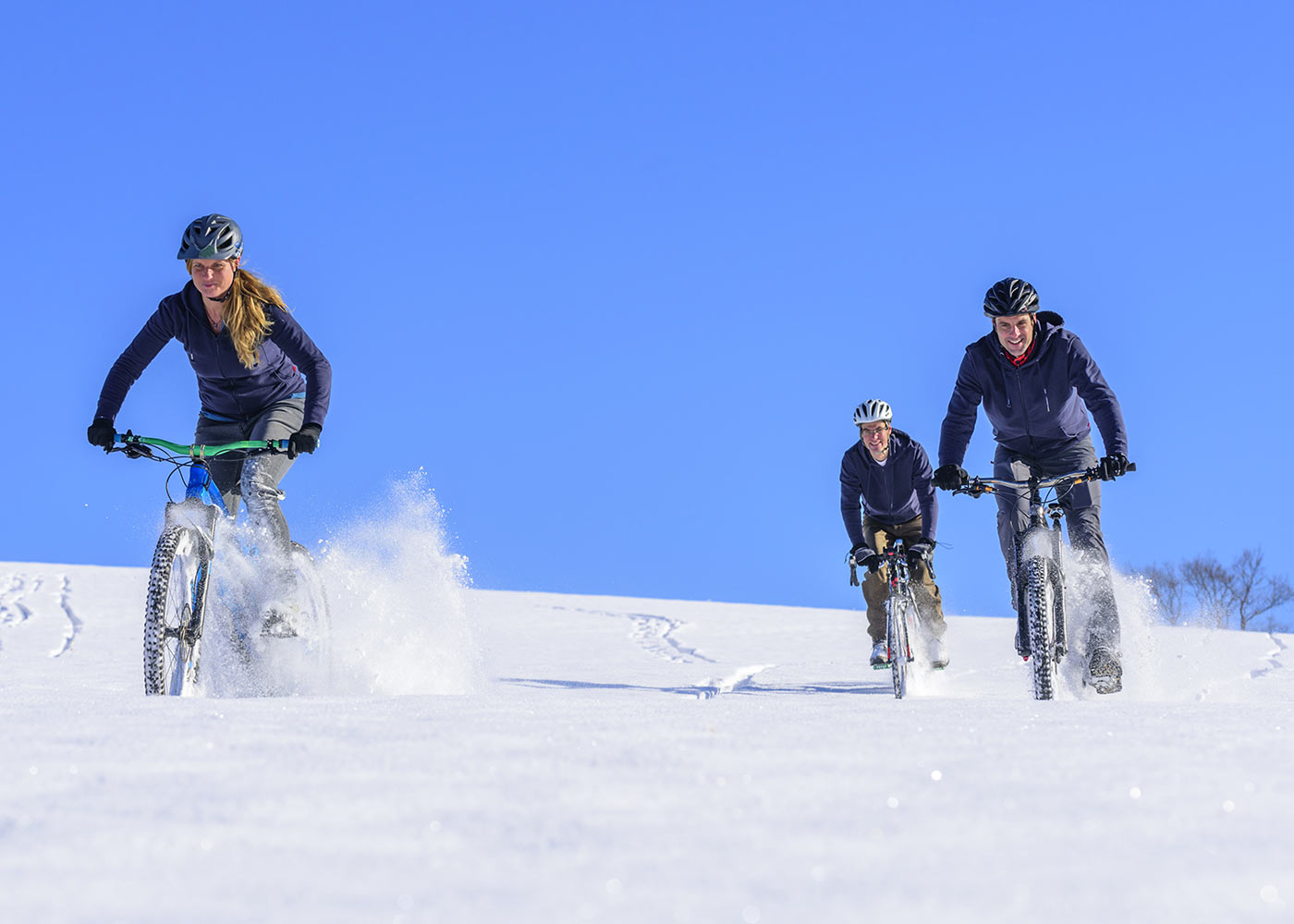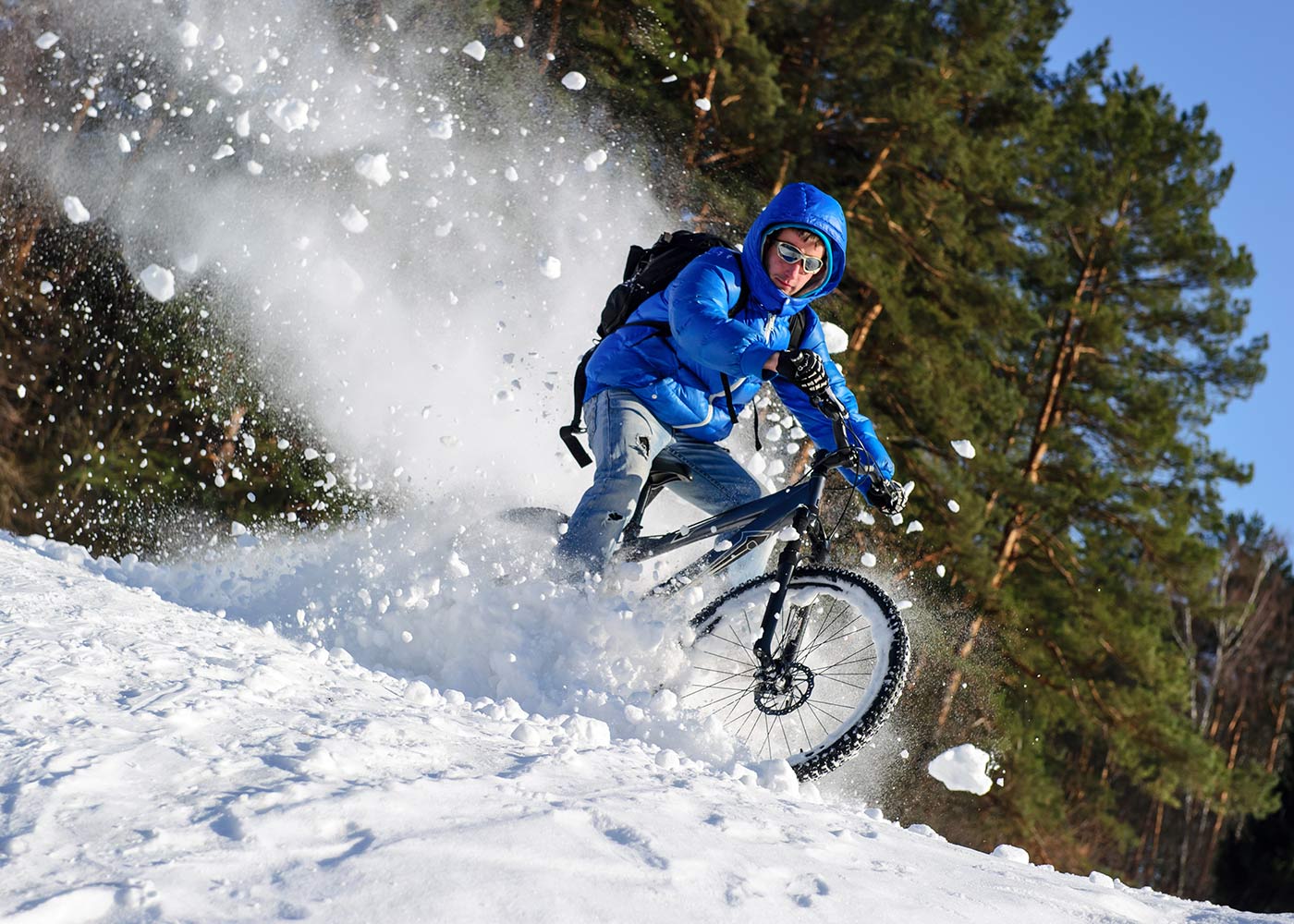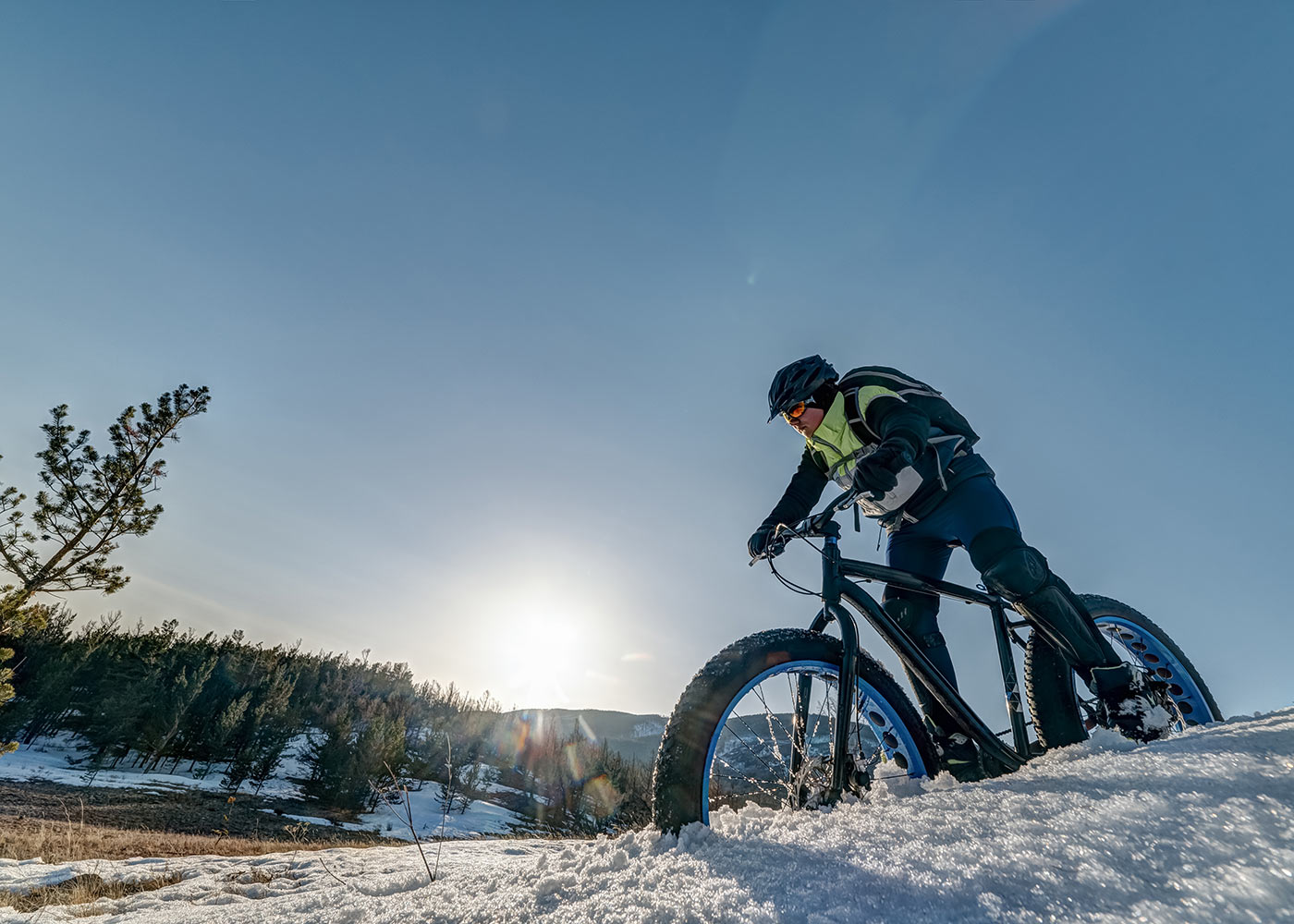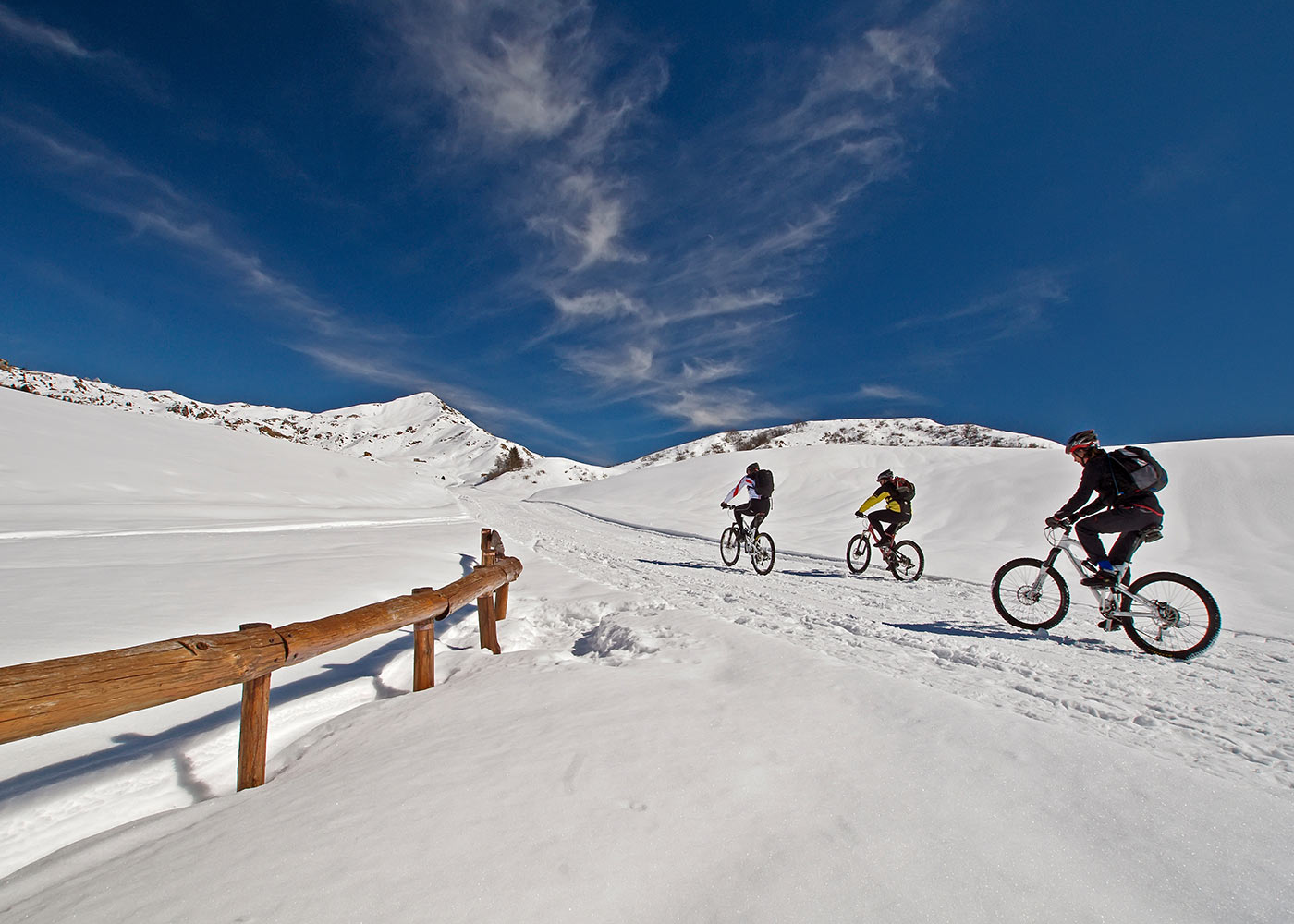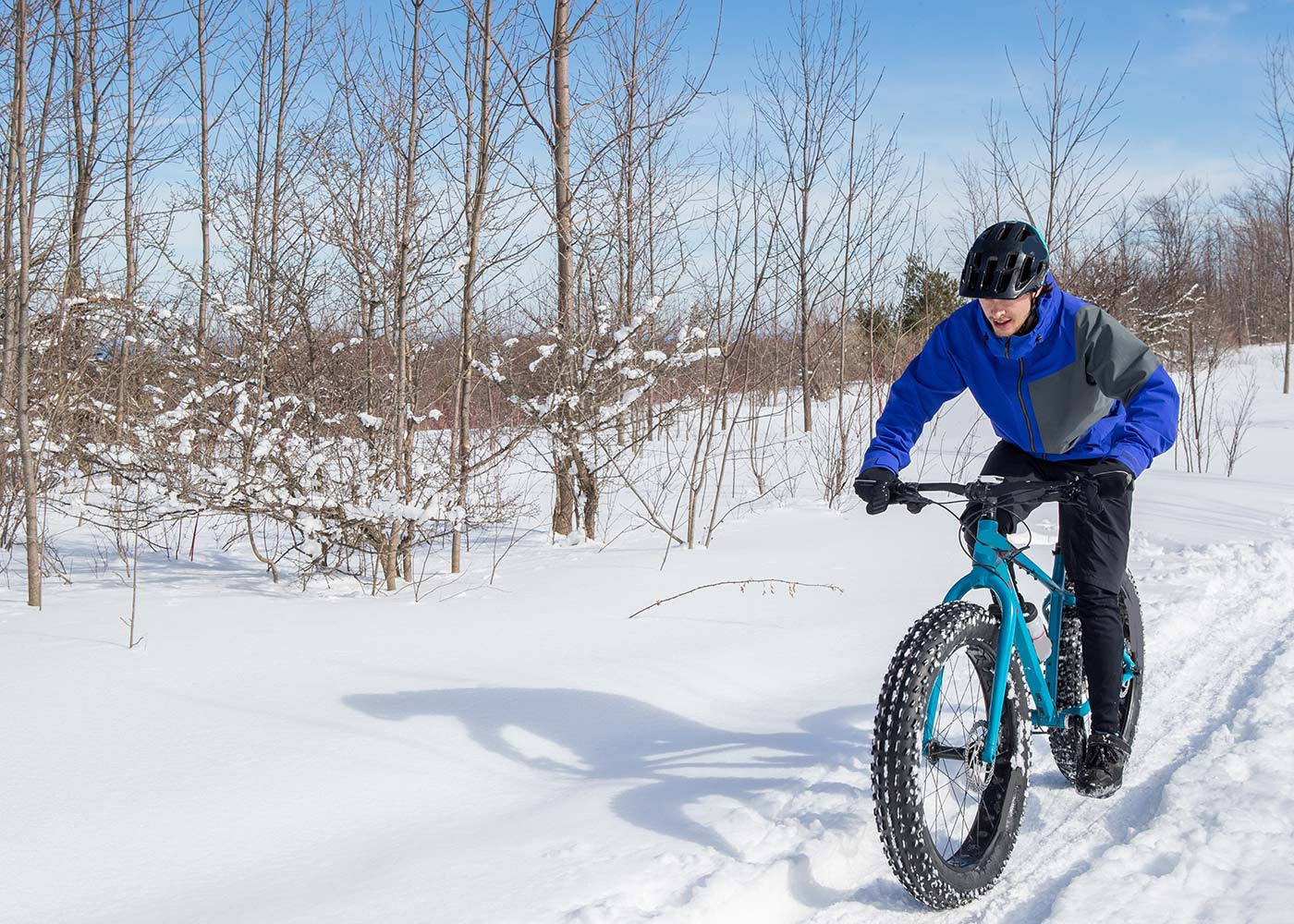Our tips for riding in snow on mountain bikes and fat bikes
Riding in snow? It’s an exciting experience that must be dealt with precautions to avoid being in situations that could become dangerous.
Here are some tips which will help you get the most out of riding in the snow regardless of what bike you prefer to use: mountain bike or fat bike.
In what fat bikes differs from mountain bikes?
A fat bike (also known as fat-tire bike) is an off-road bicycle with oversize tires , typically 3,8 inches (97 mm) or larger and 2,16 inches rims (55 mm) or wider, designed for low ground pressure to allow riding on soft, unstable terrain, such as snow, sand, bogs and mud.
Fat bikes are built around frames with wide forks and stays to accommodate the wide rims required to fit these tires. The wide tires can be used with inflation pressures as low as 340 h Pa (5 psi) to allow for a smooth ride over rough obstacles. A rating of 550–690 h Pa (8–10 psi) is suitable for the most riders.
Adjust tire pressure
Most important factor for gaining traction in the snow except for studded tires.
Fat bikes run tire pressures of less than 10 PSI. This allows for some built in shock absorption, as well as more surface area that is in contact with the ground. This rule is also in effect with (skinny) bikes in snow. You will get roughly 50% better traction if you decrease your pressure by about 50%. You won’t need to worry about a blown tube, as the speeds you will be traveling at are low and everything that could pop a tire is padded by a layer of snow.
Ride with flat pedals
Once you stop and place your foot in the snow on a hike-a-bike, you will have a hard time getting your cleat back into your pedal. Ride with flats! This also allows you to wear hiking boots and can save you from buying specific winter riding boots.
Stay seated
To gain traction in snow, your rear wheel drive bike needs weight in back to retain traction as well. When climbing a hill, you need to keep your weight back. Don’t attempt to stand unless.
Spin, don’t hammer
Important for traction. If you tend to hammer when you ride, you are going to be spinning out often (losing traction). Best to keep revolutions steady with consistent pressure along your pedal rotation. When approaching a short hill try to gain some speed and maintain that speed up the hill. Riding with flats make this difficult, but do your best.
Be sure to hydrate
One of the top reasons for frost bite is dehydration. So make sure you are well hydrated before heading out into the cold.
Riding in Powder
Tires get good traction in new powder which is deposited on hard ground or over a packed surface. Powder is light and fluffy after a storm, but over time it will get saturated, and feels like riding through wet cement. You really only have a couple of days to hit trails after a storm with the perfect powder.
Your typical skinny Mtb will be able to tread through up to 4-6″ of powder. Get used to a grinding at 3-5 mph if you typically ride at 10 mph. It’s more work. Fat bikes are technically better at riding in snow, but the work to go through powder can actually be tougher than with a skinny bike. You are moving more snow out of you way with fatter tires.
One of biggest problems with riding skinny bikes in powder is they leave skinny tire-width wide paths which are as deep as the snow. First ride through the powder will be fairy easy. Turn around and come back and that rut you just made becomes almost an obstacle. Your tire wants to follow it, but following this kind of track is impossible, so you just slide back and forth. Fat bikes make nice wide tracks in powder. Pray you are following a fat bike if you ride behind someone. That said if the snow is dense and you are sinking, even fat bike tracks are hard to follow.
Riding in slushy snow
Fat bikes are best for this stuff, but if you aren’t in powder or packed snow, it’s a challenge even on a fat bike. You can ride any bike through 4″ or so of muck, but it’s going to be very slow and quite slippery. The faster you can go through muck, the better you are going to fair.
Riding on frozen ground
When the trails get wet or snow thaws, things turn to mud quickly. You can avoid creating ruts in mud by riding early in the day while the ground is still frozen. Ice crystals on dirt create actually a fairly tacky surface to ride on. Snow that has melted and turned to ice is a different story. If the ground is uneven or tracked out, it’s going to be a losing battle.
Best idea when riding on ice is to ride with studded tires. Needless to say riding on ice is tricky and dangerous. You can lose traction within a split second. Don’t go too fast in ice. Be especially careful when riding fast around corners where there are trees. You can easily slide off the trail with no warning and tag a tree. Avoid trails with a lot of ups and downs when riding in ice.
Crusty Snow
If snow is old and has melted a little in the afternoon – it often hardens into crust overnight. Sometimes you can get lucky at high elevations and the crust is so thick you can ride on it! Granted at any moment you can break through the crust and collapse.
A more common scenario is that you need to ride through some top crust. That won’t be too much of a problem if your bike doesn’t sink too far. If you instead sink 2-4″, this becomes a real test of will power. You will be riding at 2-3 mph but is very important maintaining momentum. If you stop at all you can’t start again as the crust is too hard to break. You will have to back up a couple feet in your track get momentum from there.
Wear suitable gear
Winter riding boots are probably the most important thing you can wear in the snow.
Hiking boots that are high top and waterproof also can work – but they typically are not made for below freezing weather. Not only will your feet be battling the cold, but you will be walking your bike at times through the snow.
Good gloves: you don’t want something too bulky, but you have to wear something insulated, and waterproof. It’s helpful to get something which will group a couple fingers together. Wear some gloves which group all fingers but pointer finger together.
Head-wear that will cover your ears and provide warmth is key. Wear a snowboard helmet basically. Ski goggles fit perfect. If you plan to ride with a normal bike helmet you will need something more substantial to cover your head and ears. Even a face mask is needed at times.
Wear Goretex ski pants. They have a liner and no insulation. Wear padded bike shorts under this.
For upper body, we recommend wearing a long sleeve shirt, with a wool over the top. If it’s snowing but not super cold, wear a Goretex ski shell over this. If it’s cold but not wet you could use a lightweight down jacket. The down jacket must always kept in bag.
